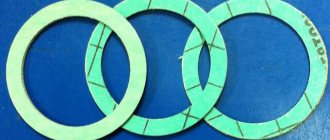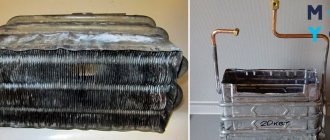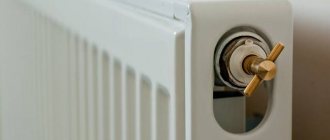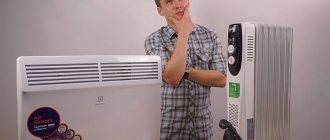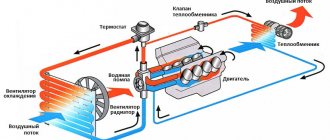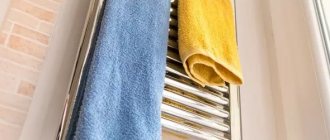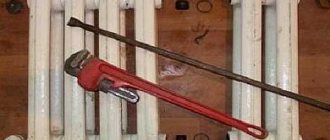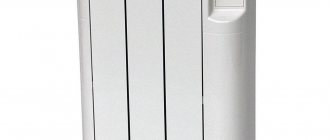From my own experience, I can say that choosing a ready-made radiator for a CVO is not an easy task.
I live in Lithuania, for the last ten years the business of transporting used foreign cars to Russia has been in full swing, literally everything that is able to leave the territory of the car market under its own power has been sold. If a car (I dare not call a pile of scrap metal a vehicle) ended up in a garbage dump (yes, yes, that’s what we call the final resting place of a car), it was immediately torn into a thousand parts. The most decent ones mysteriously spread among relatives and friends, and if car stoves were already on sale, they did not leak only thanks to a thick layer of dirt and scale.
As a result, after trying to wash and clean the stove, its appearance shows that it does not want to work normally, it prefers to let water not through the fittings, but directly onto the floor through a bunch of small (and not so small) holes. In general, she has a headache today.
And the dimensions of the old stoves are simply atas, but on newer cars the stove is a miracle made of aluminum and plastic (I would like a copper one), and a quiet, slow fan cannot blow through both of them.
Regular raids on repair shops for refrigerators and air conditioners also did not bring results. At best, we came across aluminum radiators, at worst, steel ones.
Due to the above reasons, a number of robberies were carried out at the following addresses: • A plumbing store - they managed to take away one meter of a copper tube with an outer diameter of 12 mm and eight copper corner bends for this tube • A local non-ferrous metal collection point - they managed to dig up a sheet of bronze foil with a thickness of 0. 3 mm •Electrical goods store, the result is 5 meters of copper wire 2.5-3 mm (this size determines the distance between the plates)
Then the lyrics end, the prose of life begins. Let me warn you right away that for a number of operations it is desirable (but not required) to go to a simple metalworking shop (you need a guillotine for cutting metal and a drilling machine).
I continue. Cut the foil into pieces 20 x 150 mm (I cut 60 pieces, with a margin). From aluminum 4-5 mm thick, we cut out two pieces of the same dimensions and put all the plates in a bag so that the top and bottom are just these thick plates. We tighten the whole package with a small vice. We core four holes, retreating from the narrow edge 18.75 - 37.5 - 37.5 - 37.5 mm, respectively, along the central axis.
Everyone, sit down, take a break, you can smoke, I don’t recommend beer.
We take a package of plates, beer (that’s what came in handy) and go to the nearest drilling machine, find a guy next to him in the most oily overalls, put the beer in a visible place and ask the guy to “drill only 4 holes,” with a diameter of 13 mm.
Attention, this is not a typo, exactly 13. Let me explain. Tubes with a diameter of less than 15 mm are supplied in rolls and cannot be straightened perfectly. As a result, the distance between the axes of the tubes “floats”, it will not be possible to fit ribs with 12 mm holes onto the tubes, the plates “lead”.
Thick plates along the edges of the bag prevent the bag from spreading and deforming. And one last thing. Despite the fact that we are drilling a relatively thick piece of material, I recommend using a drill sharpened for drilling tin; a simple drill, even a very sharp one, is not suitable, the bag swells, and the drill moves away. Drill lubrication is required.
We straighten the copper tube and cut off two pieces of 20 cm and two pieces of 16 cm. We take the copper wire in our hands and, using the tube as a mandrel, wind a spiral on the tube (internal diameter 12 mm), remove the spiral, cut it into rings. The result is a bunch of copper rings. We align each ring, bringing the ends of the cuts together.
There is a little trick in slicing. The ring must be cut off from the spiral so that there is a gap and the ring itself can be compressed and reduced in diameter. As a result, the ring should fit tightly onto the tube. Next, we boil all this stuff in a solution of citric acid (at the same time, we’ll clean the kettle from scale for my wife, and we’ll have something to water our bitchy neighbor’s roses with. While everything is boiling, you can drink some coffee.
Lanterns. A curtain. Maestro - MARCH.
We assemble a radiator from the parts (see figure), coat the soldering points with flux, heat it with an industrial hair dryer and solder it. Wire rings, on the one hand, fix the distance between the plates, and on the other hand, the solder poured under them ensures excellent thermal contact between the tubes and the plates. At the level of world standards, so to speak. I used active flux for soldering aluminum. One important detail. I do not recommend applying flux to the entire structure at once - the entire part warms up, the soldering process is long, and while you are soldering one part, the flux in other places “smoothly transforms, gradually transforms. ” in hard-to-remove carbon deposits.
In the picture <1>tubes 20 cm <2>tubes 16 cm <3>pieces of tube for connecting elbows <4>elbows for tube
Obviously, the dimensions in this case are a personal matter; I made a radiator to be built into the top 5.25' slot of the case, where it now works in tandem with a 12 cm fan. If desired, you can make a radiator even in a 3.5” slot of the case, even on the side wall.
With that, let me take my leave Rekill
Pay attention to how the rings are cut
Every person planning to create or update a heating system is interested in which radiators to use for this. The choice is really huge, but if you don’t know the features and key criteria, you can waste your money. Recently, you can increasingly hear about copper heating radiators. What is their advantage? This is what we will try to find out in this article.
Radiators for water heating
First, we will examine radiators designed for operation in central and autonomous heating circuits.
Register
The simplest and most affordable homemade heating radiators are made from pipes of large (100 - 250 mm) diameter, capped at the ends and connected by jumpers. These devices - the so-called registers - have a large internal volume and, accordingly, significant thermal inertia, which makes them an ideal solution for systems with solid fuel boilers.
Hint: a solid fuel boiler needs lighting every few hours. The greater the inertia of the heating system and, in particular, heating devices, the less the heated room will cool down between kindlings.
How to make a simple horizontal register?
- Pipes are cut into sections of 1.5 - 4 meters (depending on the expected length of the register).
- Holes for jumpers are drilled or burned with a gas cutter . An important point: the configuration of the jumpers should create a closed circuit inside the device, eliminating stagnation of the coolant in dead-end areas.
- The pipes are connected by jumpers - pipes of sizes DN20 - DN32.
- Parallel to the jumpers, pipe sections of the same length are welded, but already welded to the blank walls . They will add rigidity to the structure.
- The ends are capped with bottoms cut from a steel sheet 4 - 5 mm thick.
- Nozzles are welded into the lower and upper sections , which will subsequently connect the register to the supply line.
In most cases, a regular round water and gas pipe is used as register sections. It is attractive due to its low price per linear meter and maximum tensile strength with minimal wall thickness, which is ensured by a circular cross-section.
Homemade register device.
However, sometimes you can find homemade heating radiators made from a profile pipe - square or rectangular. Its advantages are the relative compactness of the register and a slightly larger surface area for the same cross-sectional area.
Important: at a constant temperature of the heating device, its heat transfer linearly depends on the surface area on which heat exchanges with air.
Convector
The simplest convector is a coil of pipe with plates pressed onto it, increasing the notorious heat transfer surface. The most accessible material is steel. New buildings often serve as sources of ready-made convectors for garage owners: apartment owners in them en masse replace the heating devices installed by the builders with sectional radiators that are more attractive in appearance and have greater heat output.
Residents of new buildings often remember the creators of this masterpiece with quiet, kind words.
However, steel has a serious drawback - low thermal conductivity. In order not to be unfounded, we will present the thermal conductivity values for three metals that are most often used in the manufacture of heating devices.
| Metal | Thermal conductivity, W/(m*K) |
| Steel | 47 |
| Aluminum | 220 |
| Copper | 401 |
It is obvious that when creating a convector it is advantageous to use non-ferrous metals: their thermal conductivity will sharply increase heat transfer, making the heating of the fins more uniform.
Homemade heating radiators made of copper are all kinds of designs based on a copper water pipe and plates - copper and aluminum. Aluminum fins are much more affordable compared to copper; some difference in heat transfer is compensated by its increased area.
To assemble the convector, solder intended for copper water pipes is most often used; somewhat less commonly, the plates are simply pressed onto the pipe.
The convector in the photo is completely soldered from a copper water pipe.
Here, plates are pressed onto the copper core, increasing heat transfer.
Comparative review of popular models
The choice of copper batteries, as noted above, is huge. But when choosing a particular model, focus not only on the cost, but also on the performance characteristics of the device. So, depending on the individual parameters of the heated room, you can select devices that are designed for 10-22 m2 of area. In this case, the heat transfer of one device ranges from 1 to 3 kilowatts. Do not forget about the large weight of the radiator - some models can weigh up to 13 kilograms.
The table below shows the most popular models. Check out their features to make the right choice.
SR-800-1000 Power – 2.4 kilowatts Height/Length/Thickness – 80×100x100 cm Price – 75,000 rubles
Autonomous heaters
What to do if there is no central heating or gas in the garage, and the frequency of your visits to the premises does not allow organizing a scheme with a solid fuel boiler?
In this case, it would be quite logical to use electricity for heating.
Oil radiator
The simplest homemade oil radiator is a welded register already familiar to us with several modifications.
- There are no welds for connecting to the connections.
- The register, as a rule, is made portable, which implies the presence of legs.
- Jumpers between sections are present on both sides. Their diameter is made slightly larger than when assembling a register for water heating. The instruction is due to the fact that natural convection implies a minimum hydraulic pressure, and if so, the hydraulic resistance should also be minimal.
- A heating element or several parallel connected heating elements are installed at the end of the lower section.
- Oil acts as a coolant. Ideally, a transformer one, but even testing will do.
- The register is equipped with a small open expansion tank. As an option, the oil is not added a little to the top of the register, and the weld on its upper section is equipped with an automatic air vent.
Homemade oil radiator.
Warning: installing a safety valve instead of an air vent is a bad idea. When triggered, it can douse the owner of the room with oil at a temperature of 60 - 90 degrees, which obviously will not benefit his well-being and mood.
Heater from a car radiator
Another interesting solution is a homemade garage heater made from a radiator.
Heater from an old radiator.
The diagram is indicated by numbers:
- Radiator.
- Expansion tank.
- Forced air fan.
- A casing that protects the fan blades.
- Water pump.
- Oil supply pipe.
- Actuator.
- Fan drive belt.
- Electric motor.
- Frame stand.
- Drain tap.
- Block of heating elements.
- Blinds for adjusting the direction of air flow.
A few tips for assembling this product:
- Partially clogged radiator tubes are not a problem. They will miss the oil.
- Optimal motor characteristics are 300 - 500 watts at 1500 rpm.
- To heat the oil, heating elements with a total power of up to 3 kW are used. It is better to provide stepwise power adjustment by switching them on separately.
Use a block of three 1 kW heating elements with each of them switched on independently.
- Due to the small diameter of the radiator tubes, it is not worth using mining in this design. Transformer oil or antifreeze A-40 is suitable.
- The heater will operate most efficiently at an oil temperature of about 80C. The temperature is regulated by selecting the power of heating elements and fan speed.
Assessing your capabilities
It is clear that not every person can assemble a homemade oil radiator, since such a design is complex, but making a device through which water will circulate as a coolant is not so difficult.
"Warm floor" - a type of radiator
According to the principle of operation, home-made heating devices also do not differ from factory-made analogues, however, it is not recommended to install these products in centralized systems with high pressure.
Instructions for thrifty owners: how to make a heating radiator with your own hands?
Homemade radiators for the heating system can significantly reduce the cost of repairs. More often, self-made registers are used for greenhouses, utility rooms, garages, and workshops.
Some use homemade (custom) radiators to add effect to the interior.
Radiators made by yourself are much cheaper even than used ones. The big advantage of homemade batteries is the ability to freely “play” with shapes and easily fit the dimensions into the calculated space.
Copper radiator: device, features and advantages
Heating devices made of non-ferrous metals are becoming increasingly popular due to their increased heat transfer, high efficiency and attractive appearance. Today we will look at the most effective of them - copper heating radiators.
Installing a copper radiator with your own hands is not difficult.
Features of device operation
If you plan to use copper radiators in your heating system, you must comply with certain requirements and rules regarding not only installation, but also the operation process. For example, manufacturers do not advise installing several copper and steel devices simultaneously along the flow of the working fluid, as this can lead to a certain electrochemical reaction that can destroy the entire system.
Note! If you cannot refuse this combined option, then be sure to use brass fittings for the connection. Today, these are sold in almost any specialized store, the assortment is huge, and the cost is quite affordable.
It is also undesirable to install copper devices in those lines that may contain small abrasive particles - the latter will, over time, “undermine” the material and sooner or later lead to wear of the radiators.
Finally, do not install such batteries if the operating fluid is very hard or highly acidic. Although some of these difficulties can be solved by installing additional special filters.
Video - Installing a copper battery
Copper radiators
Features of copper as a material for radiators
Radiator copper pipes are hidden in a protective casing.
For a long time, ferrous metal products were used as heating devices, mainly cast iron; later they began to make convectors from steel. This practice was justified by the availability and low cost of raw materials, especially in conditions of mass state construction.
If we look at ferrous metals in more detail, we will find a number of significant disadvantages that they have from the point of view of use in heating systems.
The photo shows a modern cast iron appliance.
The most significant disadvantages include the following qualities:
More recently, the market has been filled with new products consisting of aluminum alloys, pure copper, as well as combinations of aluminum and steel, aluminum and copper (the so-called bimetals).
Aluminum radiators and a copper heat exchanger are a typical combination for a bimetallic device.
Aluminum appliances required high quality and purity of the coolant, as well as stable pressure parameters in the system, which is a utopia with a centralized supply from open heating systems. Therefore, urban central heating systems continue to use cast iron and steel, because these materials are durable and not so demanding on the coolant.
But if we look at copper, we see a completely different picture:
- The thermal conductivity of copper is 401 W/(m*K) , while the thermal conductivity of aluminum is 202–236 W/(m*K), steel is 47 W/(m*K), cast iron is 25–60 W/(m*K) ). As you can see, copper conducts heat twice as well as aluminum and about eight times better than ferrous metals;
- In an aqueous environment, copper is covered with a strong oxide film within the first 90 hours, which protects the metal from further corrosion . Copper water pipes last 100 years or more;
- The metal is quite strong, but at the same time it is plastic , so it can easily withstand operating pressure of 16 atm, and pressure testing - up to 25 atm. That is, there is a high resistance to water hammer;
- The internal surfaces of pipes, unlike cast iron, are not overgrown with deposits;
- The material can be soldered with lead-tin solder , which makes it easier to install pipes and repair copper radiators.
Copper is the best raw material for heating devices.
Important! As you can see, copper is the most suitable material for the manufacture of heat exchangers, radiators and other heating devices for liquid coolant systems.
Design and types of copper batteries
The outer casing protects the device and helps it fit into a modern interior.
To understand what we are actually talking about, let’s look at the design of the most common models and types of copper radiators. Let's start with the simplest - a tubular register:
Tubular heating register.
The product is a system of two or more pipes of large or medium cross-section, communicating with each other through side collectors. Such devices are installed in large rooms, workshops, concert halls, etc.
A more advanced type can be considered a register made of small-section tubes onto which thin plates are pressed or soldered:
Simple plate convector.
Further development followed the path of complicating the system of tubes and plates, optimal distances and sizes, areas of heating surfaces, etc. were selected. An external casing was added, which closed the space between the plates and created unique air ducts that increased vertical draft and increased heating efficiency:
The distance between the plates is selected so as to create turbulent air flows.
Bimetallic copper-aluminum heating radiators appeared, which combined the advantages of both materials and reduced the total cost of production by reducing the use of copper raw materials. Today these are perhaps the most progressive and effective devices.
Aluminum fins are pressed onto copper tubes.
Important! Manufacturers of copper-aluminum models provide a 25-year guarantee on their products, and also claim the absence of overheating and positive air ionization.
Main technical characteristics
In the manufacture of modern copper batteries, exclusively high quality materials are used. Copper must be exclusively in pure form, while the ratio of impurities should be no more than 0.1 percent. It is this ratio of components that ensures the operation of the system at elevated pressure, maximum heat transfer, and also eliminates possible corrosion.
Note! Don’t forget that copper batteries in an apartment/house increases the amount of heat transferred by the working fluid by about 2 times.
Finally, copper itself is a fairly durable and strong metal, and therefore radiators made from it work quite effectively even at a working fluid temperature of 150 degrees and a pressure of 16 atmospheres.
Video - How to choose a radiator?
Features of homemade radiators made of metal pipes: types and characteristics
Design of a homemade heating battery
The design of such devices is a system that consists of horizontal or vertical pipelines interconnected by jumpers. Smooth pipes with a round cross-section are used for the production of heating radiators much more often than analogues with a rectangular or square profile. However, combined designs are also possible.
Without a doubt, registers made of carbon steel are considered the most convenient to use. The option made of galvanized or stainless steel looks much better in terms of characteristics. But, firstly, it is expensive, and secondly, only experienced specialists can work with such material.
Homemade heating devices are suitable for both single-pipe and two-pipe systems. They can be wall and floor mounted. The simplest example of execution is a heated towel rail in bathrooms. Handicraft registers are divided into two main types:
- Sectional.
- Serpentine.
Section registers
They are a pipe structure, where elements of a larger caliber are parallel and capped at the ends, and tubes of a smaller cross-section serve as connecting elements. For strength, additional jumpers can be used.
The coolant in such a battery always moves from the top tank, then through the connecting pipes it passes to the bottom row, and so on. This scheme practically eliminates the situation when the radiators are hot and the house is cold.
Judging by practical application, sectional registers cope with their tasks quite well. However, there was a fly in the ointment here. During operation of the device, it will not be possible to get rid of high hydraulic resistance; the reason for this is the difference in the diameters of the pipes and jumpers.
Serpentine registers
Such batteries look like an S-shaped structure assembled from components welded in series. The main advantage of this solution is that the diameter of the pipes is the same, which means that the hydraulic resistance is quite low. For the same reason, the coil is effective, since heat exchange is carried out over the entire surface of the homemade radiator.
A register bent from solid pipe is much more reliable in terms of operation than a welded one. But, unfortunately, it is almost impossible to carefully bend a steel pipe with a diameter of 70-100 mm at home - ideally, you need a pipe bender, and in extreme cases, a gas torch. This is where register prefabricated structures come to the rescue.
The heating system with S-shaped radiators, assembled only from metal pipes, is particularly reliable and durable; moreover, it is not so difficult to carry it out step by step. Compared to sectional batteries, there are significantly fewer welds, which means there are fewer potential sources of leakage.
Characteristics of homemade heating devices
Registers of this type can withstand pressure up to 10 kgf/m² and are able to work with any coolant: water, oil, antifreeze and steam. The permissible cross-section of pipes used in sections must be in the range of 32-219 mm.
The main advantages of copper batteries
The products described in this article are considered the most optimal option for any heating system, regardless of whether it is individual or centralized. And if we compare them with other types of radiators, then there are a lot of advantages and unique properties, which can only indicate one thing: copper radiators are one of the most profitable financial investments. And among the many advantages, it is worth highlighting the following.
- High degree of heat transfer. As already noted, pure copper is used in the production process, due to which the heat from the working fluid is transferred to the house fully and without any losses. It turns out that this is an ideal choice for many systems, in particular for a centralized pipeline in apartment buildings, where the liquid temperature, as is known, rarely exceeds 60 degrees.
- Long service life. Copper is resistant to various types of deformation, the action of corrosion inhibitors and other harmful phenomena; Copper batteries can last 15-20 years, and sometimes even 50, without causing any trouble to the user at all.
- Light weight. The copper from which these radiators are made weighs little, and therefore even the largest products with a large number of sections are light in weight. Consequently, there is no excessive load on the walls, and, accordingly, there is no longer a need to use special reinforcing fasteners.
- Low temperature resistance. At sub-zero temperatures of the working fluid, copper products may be slightly deformed, but in no case should they burst. For this reason, the risk of defrosting is practically reduced to zero.
- Economical. In the images in this article you can see for yourself that all copper heating radiators are characterized by a small cross-section. In this regard, little working fluid is required, and the user can save on fuel without any damage to the efficiency of the heating system.
- The maximum permissible temperature of the working fluid in the system is 250 degrees. This is one of the reasons why copper batteries are the best solution for grids. By the way, according to the instructions from the manufacturers, some models are quite capable of functioning at higher temperatures, achieving maximum efficiency.
- Possibility of functioning at high pressure. As noted at the beginning of the article, copper batteries also work well with a pressure of 16 atmospheres. As for the crimping pressure, for these products it can reach 25 atmospheres. It is precisely because of their increased resistance to pressure that radiators can be installed in both individual and centralized networks, and the quality of the working fluid does not play a special role.
Note! Experts recommend installing copper radiators in those heating networks where the working fluid contains a large amount of chlorine salts. After all, if you use, say, traditional steel devices for such a liquid, then in any case problems will arise - up to clogging of the pipeline.
Basic heating register calculation
If the level of heat transfer of a purchased battery can be found out from its passport, then in the case of homemade heaters you have to calculate everything yourself. Otherwise, it will not be possible to heat the room effectively and evenly.
Calculating the required radiator power to heat a room
For calculations, they use formulas that may be simple, but require certain mathematical skills. Another option is online calculators, of which there are now more than enough on the Internet. Strictly speaking, the topic is quite extensive and deserves a separate article, so we will use simple calculation methods. In any case, this issue should be given close attention, otherwise your family will complain that the radiators do not heat well and the room is cold.
A simplified method for calculating the required thermal energy is to calculate the heating area and then multiply by 100. Why is this so? Because for comfortable living per square meter you need 100 W of heat. To be more precise in the calculations, let’s take into account the number of window openings and walls:
- A room with one window and one external wall – 100 W per 1 m² of area.
- A room with one window and two external walls - 120 W per 1 m².
- A room with two windows and two external walls - 130 W per 1 m².
Important! The calculations are suitable for rooms with ceilings of no more than 3 meters, when the house is located in a moderate climate in the middle zone. If the building is located in the northern regions, then the result must be multiplied by a factor of 1.2-2.0, and if in southern latitudes - by 0.7-0.8.
Simple calculation of the thermal power of a radiator made of steel pipes
Knowing what to strive for, all that remains is to choose the design of the heating device that would satisfy your needs. How to do this?
There is an elementary solution - use a table. It already calculates the heat transfer rates of rolled pipes. The values take into account the temperature regime, in which the supply temperature of the coolant is +90℃, and the return temperature is +20℃.
Copper radiator: design features, models
Articles
If we want to install batteries with maximum heat transfer rates, then we will have to decide whether to purchase an aluminum or copper radiator. And if today aluminum products are presented in a fairly wide range, then copper is mainly remembered by specialists, and then only if they have to solve non-standard problems.
In fact, this material is ideal for the manufacture of heating equipment. That is why in our article we will tell you what the advantages of copper batteries are, and also provide recommendations for their selection and installation.
The use of non-ferrous metals can significantly increase the efficiency of heaters
Design Features
Model with tubular heat exchangers
Copper heating radiators usually have a fairly simple design:
- The product is based on curved pipes through which coolant circulates.
- Copper plates or tubes - heat exchangers - are installed on the pipes. Their significant area allows you to increase the amount of radiated heat and more efficiently use the energy consumed by the radiator.
Please note! Some designer models are produced without heat exchange plates. For their production, smaller diameter tubes are used, which have many bends.
However, even in this case, the heat transfer of the device remains high enough for effective heating of rooms.
Photo of a homemade device without heat transfer plates
- Shut-off valves are installed at the inlet and outlet of the radiator, which allows you to regulate the temperature in the room by reducing or increasing the amount of hot water passing through the circuit.
Advantages of the system and its disadvantages
Copper products used for heating a room have a very impressive list of advantages. We will analyze the most important of them in the table below:
Externally, the devices look quite stylish
| SA-550-1000 Power – 1.7 kilowatts Height/Length/Thickness – 55x100x10 cm Price – 51,400 rubles | |
| Classic Style 2195 W Power – 2.195 kilowatts Height/Length/Thickness – 42x83x11 cm Price – 34,850 rubles | Classic Style pomni 1517 RK Power 1.517 kilowatts Height/Length/Thickness – 83x11x42 cm Price 20,950 rubles |
| “Thermia 20/40 RB” Power – 0.24 kilowatts Height/Length/Thickness – 21x40x12.5 cm Price – 2500 rubles | Copperi Art V Power – 0.98 kilowatts Height/Length/Thickness – 180x75x10 cm Price – 107,400 rubles |
| Advantage | Characteristic |
| Good heat dissipation | Due to the high thermal conductivity of metal, radiators release significantly more heat into the environment than batteries made of steel or cast iron. For comparison, the efficiency of copper products is approximately 5 times higher than that of cast iron radiators. |
| Strength and elasticity | High-quality copper, which is used for the manufacture of pipes and radiator batteries, has good mechanical characteristics. On the one hand, this allows pipes to be bent without the use of welds and connecting fittings (no joint - no risk of leakage), and on the other hand, the contours can withstand even very high pressure. In addition, the possibility of bending the pipe greatly facilitates the installation work with your own hands: you can form a contour of the desired shape with minimal time and effort, using the simplest equipment. |
| Heat resistance | Radiator copper pipes, as well as metal heat exchange plates, can withstand heating up to 140 0C without deformation or change in mechanical characteristics. Thanks to this, products made from this material can be used in heating systems with high coolant temperatures, and not just in standard household networks. |
| Antiseptic properties | The characteristics of the non-ferrous metal used for the manufacture of circuits ensure inhibition of the activity of microorganisms. This is why colonies of microbes do not develop in pipes even outside the heating season. In addition, antiseptic properties protect the inner surface of the radiator. Due to the fact that the walls of the circuits remain smooth, salt deposits almost never form on them, reducing thermal conductivity. |
| Attractive appearance | Copper batteries do not need painting; moreover, any finishing is undesirable, since it reduces the level of heat transfer.
|
Pipes can withstand the highest pressures
Please note! Repairing copper radiators is also possible, and if you have certain skills, you can do it yourself. Copper is relatively easy to solder, and therefore, if necessary, you can either repair the damage or replace the leaky area with a whole fragment.
Reliability, of course, will decrease, but will still remain sufficient to withstand the pressure in the heating system of a private house or apartment.
In fairness, it is necessary to mention the disadvantages:
- Firstly, copper is a soft metal, so such batteries do not withstand shock impacts very well. And even if there is a strong load on a section of pipe, it can bend and burst.
- Secondly, the high price of non-ferrous metal does not allow these products to be classified in the budget segment. However, the long service life of radiators allows us to consider their purchase as a very reliable investment.
Copper-aluminum models
A separate group of devices consists of copper-aluminum heating radiators.
Their design involves the use of two materials - copper pipes and heat exchangers made of aluminum plates:
- Batteries of this type can have either an open or closed design . In the first case, heat exchangers are put on a coil made of copper pipe, in the second, this entire system is torn down in a casing made of steel or aluminum.
- This design of the device allows you to combine the advantages of both metals . Both aluminum radiators and a copper heat exchanger conduct heat well, but copper, which is used to make pipes, is also resistant to corrosion.
The combination of pipes from one metal with plates from another allows you to combine their best qualities
Please note! For this purpose, phosphorus deoxidized raw materials with a minimum (at the level of fractions of a percent) amount of impurities are usually used.
Thanks to such high cleaning, the pipe walls are not exposed to corrosion and deposits do not accumulate on them.
- Also, the use of copper tubes in the design makes it possible to cope with pressure drops . If aluminum can collapse when crimping heating pipes, then a more elastic metal, provided it is properly processed, can withstand up to 20-40 atmospheres.
As you can see, deciding which radiator is better - aluminum or copper - is not at all necessary. It is quite possible to purchase a product that combines the advantages of these metals and provides good resistance to external factors along with excellent heat transfer.
Recommendations for use
After selecting and purchasing copper radiators, we need to figure out how to install them correctly.
The process of soldering pipes itself is not too complicated, but still the technology for arranging the heating system has its own nuances:
- Firstly, it is not advisable to combine copper with steel or cast iron. On the one hand, we still will not be able to provide a sufficiently tight connection due to the different densities of the metals, and on the other hand, corrosion will develop at the point of contact between the materials.
Corrosion is inevitable at the junction of metals
- Secondly, both fittings and shut-off valves must be made of non-ferrous metals or alloys (copper, brass, etc.). The reason is the same as in the previous paragraph.
- Thirdly, a mandatory component of the system must be a filter designed to purify water from solid particles. If you do not install this part, then sooner or later, due to the abrasive effect from the inside, the soft walls will become rough, which will provoke the accumulation of salt deposits and the formation of a film of oxides.
It is highly advisable to use brass fittings
- All elements are connected using soldering. When designing a heating circuit, it is advisable to use high-quality solders: yes, they are quite expensive, but after hardening they provide maximum tightness and resistance to pressure changes.
- To install radiators, wall or floor brackets are used. Despite the fact that the mass of the products is relatively small, it is advisable to install plastic or rubber linings on the fastening hooks, which will protect the surface of the pipes from corrosion and deformation.
When connecting the radiator to the circuit, we use the highest quality solders
How can you solder a radiator?
On the Internet you can find many photos of how to solder a radiator. But before looking at the pictures, you need to read the recommendations of experts, otherwise you won’t understand anything.
To do everything correctly, pay attention to the procedure for soldering the damaged surface. The repair method depends on the material from which the radiator is made.
In most cases, radiators are soldered using cold welding. Instructions on how to solder a radiator are as follows:
- For convenience and quality work, dismantle the radiator;
- Find the place where the liquid may be leaking;
- To accurately calculate the fault, cover the radiator holes;
- Immerse it in water, you will see small water bubbles above the breaks;
- The damaged area must be prepared for repair - sanded and degreased well;
- We take a dose of cold welding, knead it and put it on the crack.
Due to the activator, cold welding can be turned into a liquid, which is intended for those places where it is difficult to penetrate. Let everything dry, clean and paint.
Aluminum radiator repair
Soldering an aluminum part is a labor-intensive process. How to solder an aluminum radiator? Before repairs, you need to prepare many tools, which are sold in specialized stores.
Due to the aluminum oxide film, the alloy does not adhere well to the crack, so follow this process:
- find the damaged surface;
- melt and mix rosin with iron filings;
- Apply the resulting mixture to the damage and blend with a heated blowtorch;
- when the flux covers the surface, add part of the resulting mixture. This will destroy the oxide film;
- if the gap is large, then we use a compound of bismuth and tin;
- To make the seam more reliable, we use flux - this is a composition of potassium and lithium chloride, cryolite, ordinary salt, and sodium sulfate.
The resulting mixture is heated with a hot soldering iron. At the end of the work, we check the result. Pour water with potassium permanganate into the radiator and wait a couple of hours. If it doesn’t ooze anywhere, then everything was done correctly. We work with gloves and in a well-ventilated area.
Copper radiator repair
I use the same method to solder a radiator made of copper and brass; I do this using tin. To solder a copper radiator, it is better to use a hammer soldering iron, which works without electricity. A blowtorch is used for heating.
First of all, you need to sand the cracks that have formed, then coat them with zinc chlorine. To prepare it you need: zinc and hydrochloric acid; We put the zinc in the acid and wait until the mixture combines.
Next, use a heated blowtorch to transfer the tin to the damaged area. We check the quality of work with water, then paint.
Repairing a radiator at home
The radiator is one of the most vulnerable parts of a car. If it malfunctions, it is not necessary to contact specialists; you can repair it yourself. To solder a radiator with your own hands, you need to have room and the necessary tools.
To repair the radiator, just go through the following steps:
- remove the radiator from the car and drain the liquid;
- find the right tools;
- solder the damage;
- check the result of the work;
- put the radiator back in place.
To properly fix the problem, be sure to dismantle it. At the same time, it will be possible to inspect all damage to the radiator and properly solder the gaps. We find cracks using polyethylene, a vessel and water. We cover the holes with film and then lower them into the water. Small bubbles will appear from the water above the cracks.
We wash and clean defective areas. You can sand it using sandpaper, a fine file (semicircular, thin, flat), or an iron brush. This stage must be taken seriously, since the rest of the work will depend on it.
The next step is degreasing, then sealing, it depends on the choice of the necessary tools.
To solder the radiator you will need the following tools:
- electric soldering iron;
- gas burner;
- a mixture of lead and tin;
- flux;
- rosin dissolved in alcohol.
The choice of tools for soldering depends on the material of the radiator, for example, a copper radiator is soldered with solder with a low melting degree, etc.
